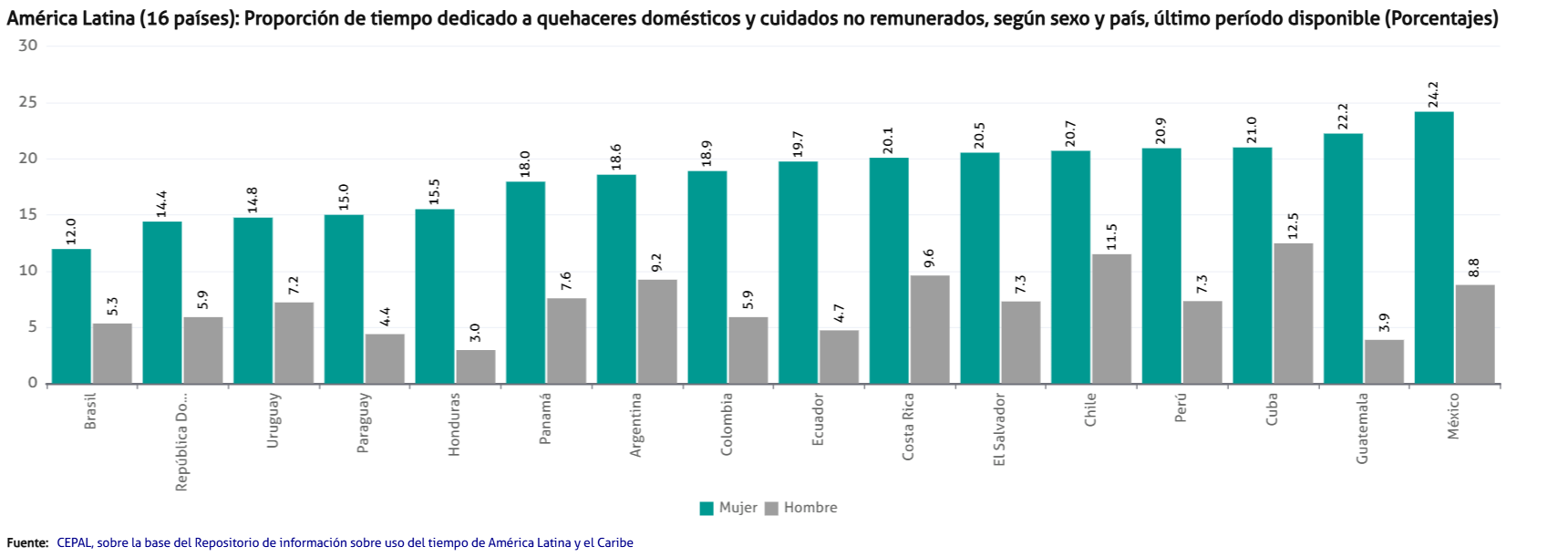
Unpaid labor is a fundamental pillar of the economy, and in many cases, it compensates for the lack of public investment in social services and infrastructure. According to UN Women, it is estimated that unpaid domestic and care work represents between 10% and 39% of PIB.
Globally, women spend 3.2 times more time than men on unpaid care work. In total, they account for 76.2% of this type of work, revealing a profound inequality. This burden of invisible tasks directly impacts their participation in the labor market, limiting their economic and professional opportunities. Unpaid domestic and care work includes essential activities for the functioning of society, such as caring for children, the elderly, the sick, or those with disabilities, as well as household chores like cleaning, cooking, and laundry, among others.
Worldwide, women dedicate 3.2 times more time than men to unpaid care work, representing 76.2% of this type of work, highlighting a profound inequality. This overload of invisible tasks directly affects their participation in the labor market, limiting their economic and professional opportunities. Unpaid domestic and care work includes essential activities for the functioning of society, such as childcare, elderly care, care for the sick or disabled, and domestic tasks like cleaning, cooking, and laundry, among others.
In Latin America, women spend between 6.3 and 29.5 more hours per week than men on unpaid work. This additional burden perpetuates cycles of inequality and limits women’s opportunities.

Note* Data from each country varies in time intervals.
The care imbalance: a structural problem
The International Labour Organization (ILO) estimates that 199 million full-time jobs would be needed to cover all the unpaid work currently done in households globally. This figure reveals the magnitude of the unrecognized contribution that sustains the global economy. Other data that highlights the gap include:
- Female labor force participation remains significantly lower than male participation in all countries in the region.
- Maternity acts as an additional limitation: approximately 60% of women in households with children under 15 report not participating in the labor market due to family responsibilities.
- When both paid and unpaid work are considered, women work between 2.4 and 20.8 more hours per week than men.
A problem with socio-economic roots
The way care work is organized varies significantly depending on socio-economic status. Families with higher resources can hire care services, while those with lower incomes face an impossible dilemma: women must choose between giving up the opportunity to enter the labor market to provide care or spending an unsustainable portion of their income on these services. This phenomenon deepens socio-economic inequalities, as women from poorer households face greater difficulties in entering the labor market, limiting their ability to generate their own income and achieve economic independence.
Towards a fairer distribution
It is essential to rethink the organization of care work, recognizing it as a social responsibility rather than just a private or family matter. To achieve this, public policies must be implemented to offer accessible and quality care, promote shared responsibility between men and women, and make unpaid work visible and valued. Moreover, it is crucial to have equal parental leave to share care tasks. Recognizing and equitably distributing these responsibilities is key to achieving fairer societies. According to the OIT, if current trends continue, the gender gap in time spent on unpaid work will not close until the year 2228.
Are you interested in this information? Learn about some of the gender projects we have carried out.
____________________________
Sources:
OIT. (2024) Las personas trabajadoras de América Latina con responsabilidades de cuidados: Una mirada regional al Convenio núm. 156